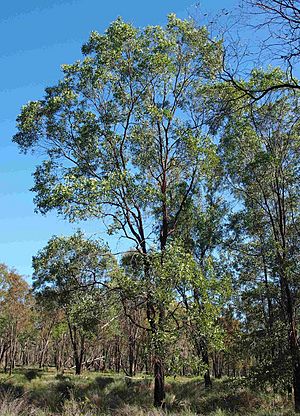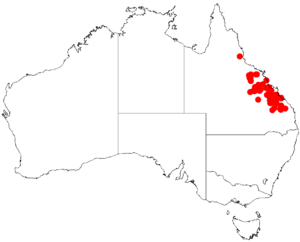Ringy rosewood facts for kids
Quick facts for kids Ringy rosewood |
|
|---|---|
 |
|
| Scientific classification | |
| Genus: |
Acacia
|
| Species: |
rhodoxylon
|
 |
|
| Occurrence data from AVH | |
The Acacia rhodoxylon, often called rosewood, ringy rosewood, or spear wattle, is a type of tree. It belongs to the Acacia family and is found naturally in northeastern Australia. This tree is known for its beautiful wood and interesting features.
Contents
What the Ringy Rosewood Looks Like
This tree usually grows to be about 6 to 20 meters (20 to 65 feet) tall. Its main trunk can be 15 to 25 centimeters (6 to 10 inches) wide. Both the trunk and branches often have a wavy or grooved look.
The inside wood, called the heartwood, is a deep dark brown to reddish-brown color. The outer wood, called sapwood, is a creamy white. The bark is dark brown to gray and peels off in small, curved pieces. This peeling bark looks a bit like the bark of "minni ritchi" trees.
The young branches are sticky and smooth, pointing upwards. Like most Acacia trees, the Ringy Rosewood doesn't have typical leaves. Instead, it has special flattened leaf stems called phyllodes. These phyllodes are smooth and leathery, especially when they are young and sticky.
The phyllodes are narrow and shaped like a spearhead. They are usually a bit uneven, with one side curved and the other straight. They can also be slightly curved like a sickle. Each phyllode is about 6 to 10 centimeters (2.4 to 4 inches) long and 8 to 20 millimeters (0.3 to 0.8 inches) wide. They have many faint lines, but three to five lines are a bit easier to see.
The tree flowers at different times throughout the year. It produces bright yellow flowers. These flowers grow in simple clusters, either alone or in pairs, on smooth stalks that are 8 to 20 millimeters (0.3 to 0.8 inches) long. The flower clusters are shaped like cylinders, about 2 to 3 centimeters (0.8 to 1.2 inches) long, and are packed with yellow flowers.
After the flowers bloom, smooth, thin, leathery seed pods form. These pods are a little sticky. As they get older, they turn brown. The pods are narrow and oblong, about 3 to 7 centimeters (1.2 to 2.8 inches) long and 5 to 9 millimeters (0.2 to 0.35 inches) wide. Inside, they hold shiny brown seeds that are arranged lengthwise or diagonally. The seeds are wide and oval-shaped, about 3.5 to 4.5 millimeters (0.14 to 0.18 inches) long, and have a small fleshy part called an aril.
How the Ringy Rosewood Got Its Name
This tree was first officially described by a botanist named Joseph Maiden in 1920. A botanist is a scientist who studies plants. He wrote about it in a scientific paper. Later, in 1987, another botanist named Leslie Pedley changed its scientific name. But then, in 2001, it was changed back to its original Acacia name.
Where the Ringy Rosewood Grows
The Ringy Rosewood tree is found only in certain areas along the east coast of central Queensland, Australia. This means it is endemic to that region. You can find it from around Eidsvold in the south up to Clermont in the north. There's also another separate group of these trees near Mount Garnett, further north.
It often grows in hilly areas or gently rolling plains in the eastern part of the brigalow belt. It prefers sandy or clay soils that don't have many nutrients. Here, it grows as part of open forests, often alongside Eucalyptus trees.
Uses of the Ringy Rosewood Wood
The wood from the Ringy Rosewood tree is very good quality and looks attractive. In the past, people used it for making fences because the wood is naturally resistant to termites. This means termites don't like to eat it, so fences made from this wood last a long time.
Today, this wood is used for many decorative items. It's great for "turned wood" projects, where wood is shaped on a spinning machine. It's also used in musical instruments like xylophones. Sometimes, it's even used for parts of violins as a replacement for expensive ebony wood. Because it has a straight grain, it's also good for sporting goods that need strong, straight timber.

